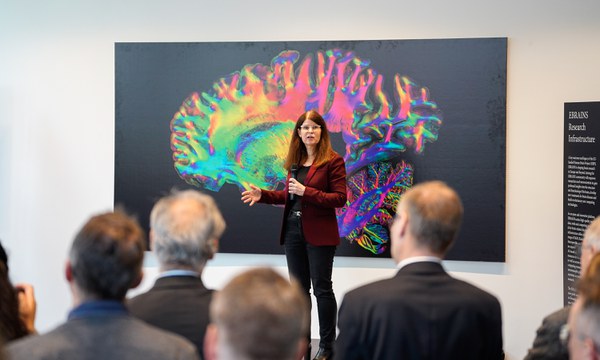24 February 2025
The artistic side of neuroscience is the focus of an exhibition that was opened on Wednesday, 19 February 2025, by Roberto Viola, Director General of DG Connect at the European Commission, and Sabine Verheyen, First Vice-President of the European Parliament, in Brussels. Entitled "Cracking the Code of the Brain", the exhibition shows a selection of scientific images from brain research conducted at the European Human Brain Project (HBP) and powered by the EBRAINS Research Infrastructure. These colourful photographs, digital renderings, and 3D simulations originate from the researchers' daily work - while also having great aesthetic appeal.

The Human Brain Project was Europe's largest funded brain research initiative to date, concluding in 2023 after a decade of collaborative work. At the intersection of neuroscience and information technology, the HBP explored the brain and its diseases using advanced methods from computer science, neuroinformatics, and artificial intelligence. It also drove innovation in fields such as brain-inspired computing and neurorobotics. The HBP gave rise to EBRAINS (European Brain Research Infrastructures) - a unique digital research infrastructure for neuroscience.
The future of brain research and its significance for Europe were addressed in the two opening speeches. Roberto Viola acknowledged that the HBP and EBRAINS had done pioneering work in neuroscience and digital innovation, contributing, among other things, to major advances in digital tools, medicine and artificial intelligence research. The EU holds a unique position in this field and must continue supporting EBRAINS - politically, structurally and economically.
In her welcoming address, Sabine Verheyen highlighted how EBRAINS can drive major advances in digital neuroscience, particularly in medical applications. She pointed out that this is of strategic importance for the EU, especially given the challenges of an ageing society where conditions such as stroke and dementia are becoming an increasing burden. In this context, she emphasised the great potential of EBRAINS in AI-supported brain research, particularly for medical innovation.
Prof. Katrin Amunts, joint CEO of EBRAINS and director of the Institute for Neuroscience and Medicine INM-1 at the Forschungszentrum Jülich, and Prof. Jan Bjaalie, Chief Infrastructure Officer of EBRAINS, from the University of Oslo, followed with keynote speeches outlining the vision of EBRAINS as a digital infrastructure for neuroscience and medicine. In her talk, Amunts explained how JUPITER - Europe's first exascale computer that's being built at Forschungszentrum Jülich - will be used to develop a foundational AI model of the human brain. At the same time, advancements in "NeuroAI" benefit from our growing understanding of the brain - a "win-win situation".

Bjaalie also addressed the role of AI, with a focus on data. He emphasised that EBRAINS hosts an expansive "ecosystem" of neuroscientific data, providing researchers with deeper insights into the brain and enabling diverse AI applications to the data. Bjaalie envisions EBRAINS' data playing a key role in the "European Health Data Space".
The exhibition is located in the Copernicus building of the European Commission and can be visited after official registration at the Visitor's Centre.

"Cracking the Code of the Brain" - Event Aftermovie
Contact Persons
Prof. Dr. med. Dr. h.c. Katrin Amunts
Director and Working Group Leader "Architecture and Brain Function"
- Institute of Neurosciences and Medicine (INM)
- Strukturelle und funktionelle Organisation des Gehirns (INM-1)
Erhard Zeiss
Wissenschaftlicher Kommunikationsreferent
- Institute of Neurosciences and Medicine (INM)
- Strukturelle und funktionelle Organisation des Gehirns (INM-1)








